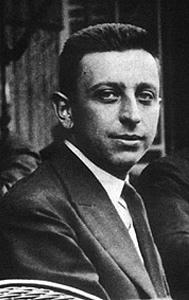Robert Desnos

Robert Desnos was born in Paris on 4 July 1900 and spent his childhood in the Les Halles district. Showing little interest in school, he preferred the world of comics and adventure novels. At the age of 16, he became a sales assistant in a hardware store. In 1918, his first writings appeared in La Tribune des jeunes (The young people's Tribune), and an anthology of his poems Le Fard des argonautes (The colour of the Argonauts) was published in an avant-garde review, Le Trait d'union (The Hyphen) in 1919. The following year, he discovered the Dada movement with Benjamin Perret and André Breton, a group that he joined after his military service in Morocco. When surrealism, which had a great influence on the literature between the wars, replaced Dadaism, Desnos became a fundamental key player: automatic writing and dreaming under hypnosis gave birth to strange poetry and aphorisms: Prose Sélavy, L'Aumonyme, L'asile ami... (Sélavy Prose, The Aumonyme, The refuge friend) "The blade that slices the affliction of the soul, does it unveil to friends the fiction of the affection?"(Prose Sélavy) Between 1924 and 1929, he was editor at La Révolution surréaliste (The Surrealist Revolution), as well as accountant, cashier and journalist at Paris-Soir (Paris Evening paper) and then at Soir (Evening), gradually dividing his love life between the singer Yvonne George - who died in 1930 - and Youki Foujita. La liberté ou l'amour, La mystérieuse and Siramour (Liberty or Love, The mysterious woman and Siramour) date from this period. In 1926, he moved to the Montparnasse district, rubbing shoulders with the Prévert brothers, Raymond Queneau and Joan Miro.
Discovering whether or not the surrealist spirit was compatible with political commitment - communism - caused the breakup of the group, leading to the trading of insults between Desnos, Prévert, Soupault and a few others with Breton, Aragon and Eluard... In the 1930s, Desnos' work developed: he wrote less, launching himself into radio - as a programme producer and advertising copywriter - and into song-writing and cinema. Coming from a modest background, he wanted culture to permeate into everyone's lives. "The moon, nest of glow worms, Makes its way across the sky. She sows on the children, On all the beautiful sleeping children, Dream upon dream, drop by drop."(Chantefables et Chantefleurs)
But the artist within him saw the international tensions as a threat to freedom: he joined the Watchfulness Committee of Antifascist Intellectuals, campaigned for the Spanish republicans and unashamedly put on a uniform in 1939. Demobilised after the defeat of June 1940, he joined the Aujourd'hui (Today) newspaper. In 1942, he joined the "Agir" (Act) Résistance network, taking part in clandestine press operations and rediscovered literature in the form of pamphlets and novels (Maréchal Duconno and Etat de veille (Marshall Duconno and Sate of Sleeplessness) etc."I am the vigil at the Golden Door Around the dungeon the Bois de Vincennes deepened their darkness I heard cries coming from the direction of Créteil And trains roll towards the east leaving a vapour trail of rebellion songs."(Destinée arbitraire)(Random Destination) On 22 February 1944, Desnos was arrested and taken to Fresnes prison. The Compiègne-Royallieu camp, to which he was transferred on 20 March, was the first stage of his deportation. On 12 May, he left for Buchenwald. On 25 May, he reached the camp at Flossenburg and then on 2 June, the sub-camp at Flohä. When the Allies broke through into Germany, the Nazis evacuated the camps, executing the deportees or sending them on one of the many dreadful staggered journeys to their deaths. Having left on 14 April 1945, Desnos thus arrived in Theresienstadt (Terezin) in Czechoslovakia, a town liberated by the Russians on 8 May. Suffering from typhus, he died on the 8th June 1945. His remains are laid to rest in the Montparnasse cemetery in Paris.

